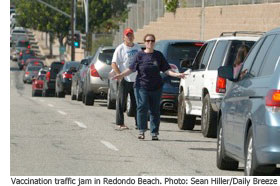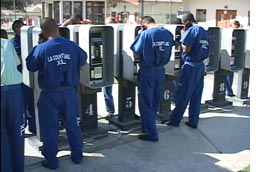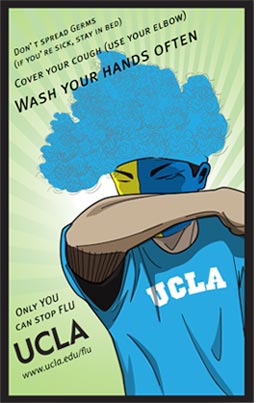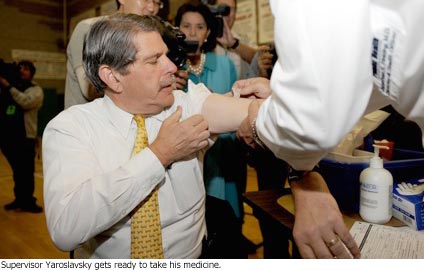Zev speaks at United Way’s HomeWalk 2009, 10/07/09
November 10, 2009
Confronting H1N1 rollout concerns
November 10, 2009
As members of the Board of Supervisors on Tuesday detailed a litany of concerns about the rollout of the county’s H1N1 vaccination program, public health officials announced steps they are taking to address the problems, including establishing more large regional clinics, making lines move faster by screening patients earlier and finding ways to better reach African Americans who so far appear to be under-represented in the ranks of the inoculated. 
During the board’s weekly meeting, Supervisor Zev Yaroslavsky acknowledged the difficulty of the department’s task. “The bottom line of all this is that you just don’t have enough vaccine,” the supervisor said. But he also urged health officials to focus attention on holding more clinics in the mid- and eastern San Fernando Valley. After the board’s session, public health officials said clinics are scheduled for Panorama and Sunland.
Supervisor Mark Ridley-Thomas said he was troubled that African Americans are not being vaccinated at a rate that reflects their presence in the population. “What has happened to date is not acceptable,” Ridley-Thomas said, adding that he has “very substantial concerns that I expect will be addressed in short order.”
Dr. Jonathan Fielding, the county’s director of public health, said the department is still analyzing the demographic data but that he, too, is troubled by the black turnout, which he said could be partly attributed to mistrust of the vaccine itself, as well as to historical distrust of such programs.
After the meeting, Fielding said he could not yet release demographic information on who’s received shots so far. “We have very gross data that is subject to misinterpretation,” he said. He added, however, that concerns about the under-vaccination of African Americans are certainly valid.
Overall, Fielding said, there have been 74 H1N1 deaths in the county and 200 hospitalizations last week alone. He said he believes the outbreak is “at or near its peak” but that it is difficult to know for sure.
In all, the county has received 810,000 doses of vaccine so far, with 538,000 of those going to private providers and the rest to the Department of Public Health. Of the county’s allotment, 113,000 vaccinations have been given in 69 county H1N1 clinics.
Although vaccine shortages are easing somewhat, Fielding said, the “current supply is inadequate.”
Officials estimate there are 5.5 million people in Los Angeles County who fall into high-risk categories for the infection, commonly known as the swine flu. Millions more should get the injections as well, after the high-risk population has been inoculated.
The shortages have thrown a major kink into the county’s vaccination plan, which in some respects was based on disaster preparedness models set up to handle public health emergencies such as an anthrax attack. Because both vaccine supply and turnout have been highly unpredictable, some clinics have been lightly attended while others have been overwhelmed, with up to 3,000 people queuing for hours.
A drive-up clinic in Redondo Beach created traffic havoc; Board of Supervisors Chairman Don Knabe described it on Tuesday as “just catastrophic.”
Later this week, public health officials will post their latest list of vaccine clinics on the department’s website. They noted that they have shifted their emphasis away from smaller neighborhood events toward large-scale, regional clinics where traffic, parking, public awareness of the site and medical logistics can be better managed.
An advertising campaign, tabled when the vaccine shortages appeared, will also be revived in coming weeks. That may help target African American communities, though Fielding said it will be important as well to enlist “spokespeople with the trust of the community” to spread the word, too.
Public health officials also are trying to cut down on long waiting times with “early line management”—taking medical history information from patients and determining which of several modes of inoculation would be most suitable for each, even before clinic doors open.
“It’s complicated in real time when you have people waiting to be immunized,” Fielding said, noting the array of vaccine variables: nasal mist, injections, multiple dosage packaging, single dosage packaging, with preservatives and without.
Health workers have also started moving through clinic lines to let those waiting know how much vaccine will be available at a given site and to divert lower-priority patients to later sessions.
Even the high-risk classifications themselves can change; Fielding said today that morbid obesity has now been added to the priority group list.
After the meeting, Jonathan E. Freedman, chief deputy of the Department of Public Health, said that even with all the obstacles, the pace of the H1N1 vaccination program in just a few weeks has outstripped the usual 60,000 to 70,000 injections that would be administered during a typical flu season.
Zev with Placido Domingo at the Hollywood Bowl, 08/09
November 6, 2009
Los Angeles County Supervisor Zev Yaroslavsky sat down with Placido Domingo for a very special interview at the Hollywood Bowl.
H1N1 vaccine clinics launch in LA County, 10/23/09
November 6, 2009
Board Supervisor Zev Yaroslavsky speaks at the press conference in Encino at the launch of the H1N1 flu vaccine clinics in Los Angeles County.

Welcome to my new website
November 3, 2009
 More than three decades ago, in my mid-20s, I took my first oath of office as a member of the Los Angeles City Council. Today, I’m 60, and one of our county’s longest-serving elected officials. I’d like to think that constituents have given me the privilege of serving them on the council and the Board of Supervisors because they know I’ve consistently put their needs first.
More than three decades ago, in my mid-20s, I took my first oath of office as a member of the Los Angeles City Council. Today, I’m 60, and one of our county’s longest-serving elected officials. I’d like to think that constituents have given me the privilege of serving them on the council and the Board of Supervisors because they know I’ve consistently put their needs first.
No doubt, many of you find the world of government—particularly L.A. County government—foreboding and complicated, a place where the rich can pay lobbyists to push the levers of power while the poor are forced to rely on the integrity of a system that, to them, seems unremittingly rigged against them.
Yes, Los Angeles County government is sometimes frustratingly flawed, with consequences that can mean life or death for those who rely on its safety-net services. But it also can be powerfully effective, even transformative, in the lives of those it serves, from vulnerable children to the frail elderly. From my vantage point in the arena, I know that the real story of Los Angeles County government is more layered than the image that often emerges in the news accounts that shape public perceptions.
In recent times, that picture has become even more one-dimensional as the rise of the Internet has delivered a serious financial blow to the mainstream media, forcing them to thin the ranks of reporters, including those who cover our local political institutions. For the most part, the coverage they continue to offer is important but is simply too spare to provide a true understanding of the breadth of issues that confront us or of the people who take to heart their role as public servants.
This new website represents my commitment to share with you more of the story of Los Angeles County—what works and what doesn’t. Along the way, I hope to inform, inspire, entertain and motivate you to become active in the issues you and I care about so we can become even better partners. My name, of course, is at the top of this website and, now and again, you may see a picture of me cutting a ribbon or shoveling some dirt at a groundbreaking. But our goal is to promote the issues, not me.
The reality is that this website, reported and written by my staff, is an experiment, representing a new kind of online outreach. There is no time-tested model to follow, just my instinct that you want and need more than you’ve been getting from traditional political websites or from the media.
Let me be clear, we’re not purporting to be a journalistic organization or to end-run traditional news outlets with propagandistic content. We are simply offering you another stop on your daily journey through the web for deeper coverage in areas we’ve long considered priorities: health, transportation, the environment, arts and culture, public safety, social services and the economy.
Finally, I want to encourage you to let me know what you like about the site and what you’d like to see improved. Like most websites, this one will continue to be a work in progress. What you see today is just the beginning as we try to figure out ways we can be more useful. And for that, I need your help. Please drop me a note with your thoughts at [email protected].
Thanks for stopping by.
Read more blog entries.
Giving new meaning to pet projects in government
November 3, 2009
The leggy young thing seemed a bit nervous, even though she looked great—impeccably groomed, hot pink bandana around her neck. She was accompanied by a couple of handlers to stage-manage every step of her debut performance.
She shook ever so slightly as she waited for a photographer in the VIP parking lot. Eventually, she managed to nibble a few greens, and then—paging TMZ!—she urinated! In public! Right there on the grass!
“It’s always a new adventure,” says Evelina Villa, Los Angeles County’s puppy wrangler, as she scooped up young Madeline, the eight-week-old shepherd mix, who was the day’s star attraction, and headed into the Hall of Administration.Ordinarily, Villa, 24, tends to administrative responsibilities in the Long Beach headquarters of the Department of Animal Care & Control. But most Tuesdays, she goes to The Show—the Board of Supervisors meeting. There, she hands off the animal to Supervisor Michael D. Antonovich, who says a few words to coax would-be adopters attending the meeting or watching the next night on cable TV. ![]()
But before the big show-and-tell moment, Villa presides over a behind-the-scenes ritual that has become part of the culture of board meeting days, a folksy tradition that seems more Mayberry than metropolis. In all, nearly 650 pets have found homes—hundreds with county employees—since the program was started by Antonovich in 1995.
In fact, Villa starts the search on behalf of each animal at the very top, making the rounds of each supervisor’s 8th floor office. The No. 1 priority is finding a home for a needy pet, whether it’s with a soft-touch chief deputy or John Q. Dog Lover.
So just before 9 a.m. on a recent Tuesday, there was Madeline on the red carpet in Antonovich’s office, where the “shepherd mix’” part of her lineage was being debated. “Looks like a Jack Russell,” someone says, sizing up Madeline’s tan and cream markings—patches over both eyes, white strip down the nose.
As Villa moved among the board offices, sporting her “Travelin’ Tails” tote bag, she kept her spiel going: “Anyone interested in adopting a little puppy today? This is Madeline. She needs a home.”
In Supervisor Gloria Molina’s office, staff assistant Carlos Huezo looked like a soft touch—he’s already gotten one puppy from Villa, a German shepherd-boxer mix named Cougar. But on this day, he passed. “Maybe next time,” he says, adding: “We’ve all adopted here.”
Then it was off to the office of Supervisor Zev Yaroslavsky, where staffers have adopted a number of pets over the years, including Row-Z, a shepherd mix who now lives with chief deputy Alisa Katz.
“What do we have here? Ooh, she’s precious,” coos Regina Marquez, a longtime Third District caseworker who last year adopted Rex, a pug-Pekinese mix.
Next stop: the seventh floor offices of Chief Executive Officer William Fujioka, who bent down and attempted some dog-speak: “Maddy, Maddy, Maddy….Hey, baby….Good girl….”
Somebody offered a Pup-A-Roni snack strip. Then they were off to the 3rd floor, where, at 10:03 a.m., Villa made the handoff to Antonovich. Madeline’s moment in the limelight had begun. And, just as quickly, ended.
“So that was it, 10:05,” Villa said. Villa, who majored in business and theater at Whittier College, finds that her current job requires a bit of both: she handles all the finery of dog presentation—bandanas, collars, tiny T-shirts—and also keeps a spreadsheet on where each animal ends up. So she knows at a glance that a lab mix named Cody, for example, went home with a “relative of BOS.”
She administers a 19-point questionnaire (“Do you have a fenced yard?” “How many hours of the day will this pet spend alone without any supervision?”) to would-be adopters. If there are multiple applicants, Villa stages a drawing, with a co-worker picking the winner. New owners pay adoption fees and spay/neuter charges that range from $30 to $100, depending on the type of pet and the length of time the animal has been in the shelter.
So far, Villa has resisted the temptation to nab one of the prospective adoptees for herself, although she once had a close call with a Shi-Tzu mix named Lady.
On this day, she was accompanied by Daelene Jimenez, an animal control officer from the Baldwin Park shelter, who was learning the ropes. (In addition to showing off the animals, the department wants to showcase the range of occupations it offers at its six shelters, and sometimes sends animal control officers and animal care attendants to the board meetings to present the pets Villa has selected and named.)
For Jimenez, this meant an early wake-up call and responsibility for another crucial part of the Tuesday ritual—giving Madeline a bath. Jimenez also got a crash course in the tricks of the trade, meant to avoid any dogs-gone-wild moments involving elected officials. Rule No. 1: Always start the day with a potty break on the Temple Street lawn.
Soon, some older animals will be getting their star turns, as well.
“The puppies we have no problem adopting; we’re hoping to give exposure to some of the beautiful older pets,” says Villa’s boss, Michelle Roaché, deputy director of the department’s Outreach and Special Enforcement Division. (Cats are sometimes featured, too, but don’t ask Villa to wrangle them. She’s allergic.)
It is a point of pride that “100% of the animals featured, including dogs, cats, rabbits, birds, and a guinea pig have been placed in new homes,” says Antonovich spokesman Tony Bell.
As for Madeline, no county employees stepped up to adopt her during Villa’s rounds. “Usually, if we do have takers, I would know by now,” Villa says before heading back to her office. So if no one from the public steps up either, then Madeline would head to a rescue organization, which would continue the hunt. “Our goal is to get the dogs out of the shelter,” Villa says, “It’ll end up good for her.”
In the 12 months ending July 1, 25,246 of the 45,356 dogs impounded into county shelters found homes—nearly 56%. Those who’d like to adopt can check out the department’s website.
Trying to tame the fearsome 405 [updated]
November 3, 2009
 The Sepulveda Pass—three words that strike terror in the hearts of drive-time commuters everywhere. But an ambitious project funded partly with federal stimulus dollars is aiming to ease the fear factor on the 405.
The Sepulveda Pass—three words that strike terror in the hearts of drive-time commuters everywhere. But an ambitious project funded partly with federal stimulus dollars is aiming to ease the fear factor on the 405.
It won’t happen overnight. By the time it’s completed in the spring of 2013, however, the project will create a 10-mile northbound carpool lane on the 405 between the Santa Monica (10) and Ventura (101) freeways. It will provide a crucial connecting link in the freeway’s carpool lane system extending north from the Orange County line.
Relief can’t come soon enough for the hundreds of thousands of commuters who travel through the pass each day. They currently experience 15,000 “vehicle-hours” of delay daily; Caltrans estimates that unless something is done, the congestion would hit 27,800 vehicle-hours by 2015 and 59,430 by 2031.
“Most of the commute would be at a complete standstill,” says Mike Barbour, Metro’s project director on the 405 work. “If we don’t do this, it will be horrendous.”
The work extends beyond adding the carpool lane. Workers will also realign 27 on- and off-ramps; widen 13 overpasses and structures; build some 18 miles of retaining and sound walls, and remove and replace bridges at the Skirball Center, Sunset Boulevard and Mulholland Drive. Oh, and they’ll be doing some road improvements on nearby streets, too.
It’s a big job—officials say the project will create 18,000 jobs during construction, although not all of those are local. For now, workers in the pre-construction phase are busy surveying storm drains and utilities, and doing the soil testing that is essential to the design process. Project officials also are working with a community advisory committee made up of homeowners and neighborhood councils to get feedback on the design process, and will continue working with the group though construction. A community meeting will be held Nov. 19 from 6:00 to 8:00 pm at the Skirball Cultural Center, 2701 N Sepulveda Blvd, Los Angeles.
Signs will be posted to let motorists know when the project is expected to begin and end. Traffic lanes will be reconfigured and a safe work zone set up behind those concrete barriers known as “k-rail.” Once that’s done, officials say, northbound drivers should have the same five lanes available during the project as they did before it started—and will, of course, have a new 6th lane for carpools when it’s done.
“We are doing everything we can to reduce the overall construction time frame,” Barbour says, adding there is an incentive for the contractor to finish early. Barbour urges commuters to check the project website frequently for updates during construction.
The project, a partnership of the Los Angeles Metropolitan Transportation Authority (Metro) and the California Department of Transportation (Caltrans), is expected to cost $1.034 billion, with $189.9 million coming from the American Recovery & Reinvestment Act of 2009 (ARRA) and the rest from state and other federal sources.
Updated, 11/10/09:
Just in time for the holiday rush at LAX, Caltrans has opened the new carpool lane on the southbound 405 from the Santa Monica Freeway to the Marina Freeway (SR-90.) The northbound carpool lane covering the same stretch is set to open before Thanksgiving.
“It’s going to definitely alleviate the flow of traffic, especially during the holidays,” when carloads of travelers picking up or dropping off passengers can take advantage of a high-occupancy lane, says Sgt. Jim Holcomb of the LAX Airport Police.
The five-year, $167 million project—which also included work on National, Culver and Palms boulevards—makes it possible to travel via carpool lane on the southbound San Diego Freeway from the San Fernando Valley through Orange County.
Updated 12/29/09:
Night work on the 405 carpool lane project begins Jan. 12, with closures of ramps, individual lanes and the entire northbound freeway planned for various times through mid-March. The work—to lay out temporary lanes and set up protective work barriers—will take place from 7 p.m. to 6 a.m. on weekdays, with full closures slated only between midnight and 5 a.m. As the project moves forward, look for updated information on lane and ramp closures here.
Jail phone calls ring up big bills
November 2, 2009
 Responding to complaints about the high cost of telephone service in Los Angeles County jails, the Board of Supervisors has moved to open up bidding on the multi-million dollar jail phone contract in an effort to lower the cost of calls while still providing key funding for jail programs.
Responding to complaints about the high cost of telephone service in Los Angeles County jails, the Board of Supervisors has moved to open up bidding on the multi-million dollar jail phone contract in an effort to lower the cost of calls while still providing key funding for jail programs.
The jail phone contract with the Sheriff’s Department governs the rates charged when inmates call family, friends and attorneys from the jails’ nearly 4,100 telephones. The current provider is Global Tel*Link, a privately-held Alabama firm that operates phone services in jails and prison systems nationwide, including many in Southern California.
The contract brings in about $30 million a year. The company keeps 48 percent while paying 52 percent to the Sheriff’s Department, which uses the money to help pay for inmate programs and jail maintenance.
The contract, which runs through December 2010, allows GTL to charge $3.54 for the first minute of a collect local call from the jail, making the average call of 17 minutes a $5.20 expense for the inmate families, according to a 2008 report by the county CEO’s office, prepared for the Board of Supervisors. The county initially cut the deal in 2005 with the then-SBC/AT&T, which later sold its jail business to GTL. Inmates can also buy prepaid phone cards and save 10 percent on calls, but few do.
The rates are among the highest in the region, about 10 to 30 percent above most prices paid in other county jails and many prisons nationally.
GTL says the county negotiated and approved the contract in 2005. The company says comparisons of per-call rates from one jurisdiction to another are unfair. “Variability in rate structures and costs [between counties] is to be expected” because each jail system negotiates prices based on a different menu of services and product features, GTL’s western regional vice president for sales, Michael Palovik, said in an e-mail exchange.
Palovik says GTL prices in L.A. can be as low as $3.35 for the first minute during daytime local collect calls; later minutes can cost as little as $.759 per minute.
The amount of money charged is controversial because studies show that maintaining strong family contact during incarceration through phone calls, correspondence and visits can aid parole success and reduce recidivism.
The supervisors believe it’s possible to get a better deal for both the inmates and the county if several companies vie for the next contract, which begins in January 2011. “The one way you find out about the best deal is you put all the sharks in one tank and let them fight it out,” Supervisor Zev Yaroslavsky said during a board meeting last year.
County CEO William T Fujioka agreed. “I’m absolutely convinced, you put this out on the street, we’re going to get a more competitive contract,” he told Supervisors during the 2008 meeting. “The County wants to achieve two goals. One goal is to lower the rates. The second goal is to make sure that this valuable resource for the Sheriff’s Department is maintained.”
Supervisors rejected a GTL offer to pay the county a $3.5 million fee to extend the current contract through 2013. The supervisors’ goal in putting up the contract for bid is to lower per-call costs to families while maintaining steady revenues for the Sheriff’s Department.
The fund nets about $15 million a year for the sheriff’s Inmate Welfare Fund, which helps supplement the costs of inmate education, drug recovery and training program as well as maintenance programs in the overcrowded jails.
The Sheriff Department’s 52 percent cut is “at the high end of the range” compared to figures paid to other correctional facilities, according to a County CEO’s report last year. Most commission rates, as they are called, fell between 40 and 56 percent.
As his office is preparing the terms of the Request for Proposal, the initial step in soliciting new bids, Sheriff Lee Baca is pushing against any plan that would lower revenues to the department. “I oppose any effort by the Board to alter the rates through a bid process,” Baca told Supervisors in a letter dated September 22.
“We can’t look at this from the perspective that the inmates are overcharged, because they are not,” he told Supervisors at a hearing last year.
The first-minute charge exceeds every Southern California county except Orange County, which charges a flat $4 rate whether the call lasts a minute or an hour. The price of the average Los Angeles call, at $5.20, is roughly 10 to 30 percent higher than other jurisdictions, except San Bernardino ($6.40)—including several operated by GTL. A 17-minute call from an LAPD lockup is $4.48, similar to Ventura County’s $4.49. In Riverside County, the call would run $3.73.
“How could it be possible that a company can charge people fees like that?” complains Evelyn Boligan, whose son Nicholas, 21, awaits trial for attempted murder. Boligan, a Department of Motor Vehicles employee from Gardena, paid over $900 in collect phone calls during her son’s first five months of incarceration in 2007 at Men’s Central Jail.
She complained to the company without success about charges for dropped calls or conversations she had to cut short because of static or overwhelming background noise at the jail. But she is unapologetic about the value of staying in touch with her son. “I had to pay those bills,” she says. “When it’s your child, you want to know that he’s okay.”
GTL’s Palovik counters by pointing out the rates are set in the terms of the county contract. The decision as to how often and low long to talk with inmates is at “the discretion of persons who chose to accept those calls,” he says.
Some families say they have had to reduce phone calls from the jail. After Janet Harris’ son Andrew Arthur, 20, was arrested on assault with a deadly weapon charges this summer, she says her phone bill shot up significantly. Even the second month’s additional $68 in jail calls was too high for Harris, a custodian at LA County + USC Hospital. “I had to tell him he could only call me every two weeks,” says Harris. “It was too high.”
Defense lawyers complain that the collect call system interferes with client contact. Glendale criminal attorney Sue Brown says she cut off client calls from jail clients after getting angry over high rates and charges for calls she never received. “It’s really a rip-off,” Brown insists. “Now I go visit my clients at the jail. It really interferes with my representation, but I don’t think I have to sacrifice my principles to represent my client.”
Attorney Christopher McCann notes that whenever he adds another $50 to the debit account that allows the clients to call him collect, GTL takes a $9 cut. “They call it a one time transaction fee,” he complains. “Well, it’s one-time every time I do it.”
H1N1 vs. “The Invincibles”
November 2, 2009
 It’s safe to say that thermometers are not a typical part of dorm welcome kits for incoming UCLA students.
It’s safe to say that thermometers are not a typical part of dorm welcome kits for incoming UCLA students.
But they are this year. It’s just one way that H1N1, known on the street as the swine flu, is changing the flu season conversation for a whole generation of young adults not used to being in the “high priority” hotseat.
In short: This ain’t your grandma’s flu.
Emily Bossak, a 22-year-old UNLV graduate who recently moved here and plans to attend UCLA law school, wouldn’t ordinarily get a flu shot but decided to get vaccinated recently at Los Angeles County’s first H1N1 immunization clinic in Encino.
“Usually when I think seasonal flu, I think people 50 and over,” Bossak says.
Senior citizens, who ordinarily turn out in the biggest numbers for seasonal flu shots, don’t even make the priority list for H1N1—unless they fall into one of the other risk groups. (In addition to young people from ages 6 months to 24 years, those groups are: pregnant women; those caring for infants younger than 6 months; health care and emergency workers, and people from ages 24 to 64 years with health conditions that put them at higher risk for flu-related complications.)
Medical officials believe that older people may have picked up some immunity from exposure to a similar flu strain in the 1950s. In any case, those most likely to be hospitalized this time around are in their teens.
“I actually read that book ‘The Great Influenza,’” Bossak says, noting that she was struck by the magnitude of the 1918 pandemic—“especially with all the deaths in my age group.” She adds that her father, a doctor, recently told her that one of his colleague’s daughters had died of the disease.
Does this kind of heightened awareness mean that all her friends are lining up to get vaccinated, too? Not so much. “They’re more afraid of the symptoms of the shot,” Bossak says.
To encourage awareness, dispel myths, promote good flu season hygiene and put out fast-breaking news about H1N1—particularly about nationwide vaccine shortages—Los Angeles County public health officials are using youth-friendly channels such as Twitter and YouTube to spread the word, along with the department’s website.
In addition, Dr. Alonzo Plough, the department’s director of emergency preparedness, recently provided a briefing for college newspapers.
Young adults—sometimes described as “the invincibles” for their it-can’t-happen-to-me outlook—are an important group to reach, health officials say. “That’s the age where we all believe we’re invulnerable,” Plough says. Not only do they often live with roommates—“How quickly this can spread in a dormitory population!”—but this age group also has a “tendency to be uninsured.”
For people who cannot get immunized through a private provider (or in the case of students, through a university health service), the county is hosting a series of free H1N1 vaccination clinics, at locations including Hollywood Park and the Pomona Fairplex, as well as at recreation centers and a number of college campuses, including two at the USC-Lyons Center and Santa Monica College. (The complete list is here.) Because of vaccine shortages, however, officials for now are asking those who do not fall into priority groups to wait until expected shipments arrive in coming weeks.
At the county’s first vaccine clinic in Encino, Dr. Jonathan Fielding, the county’s director of public health, received the first shot. Part of the healthcare worker priority group, he suited up in his white doctor’s coat and administered the vaccine to Los Angeles County Supervisor Zev Yaroslavsky. His priority group: adults with underlying medical conditions, in his case, diabetes.
“When was the last time you gave a shot?” Yaroslavsky joshed as he rolled up his sleeve, smiling and later telling reporters, “Jonathan Fielding actually administered the shot and I didn’t even cry. It was a wonderful experience.”
After that came Jaxon Irribarra, 13 months, and his 24-year-old mother, Jessica Gonzalez.
“This is the first time I’ve gotten one,” Gonzalez says. “We both fall in the high risk groups, and I thought it’s better to be safe than sorry.”
Yaroslavsky calls the rollout “the largest mobilization of public health since the polio epidemic of the mid-1950s” and called on the public, particularly those in priority groups, to get their shots, too:
“By receiving the H1N1 vaccine, you not only protect yourself, but you protect your loved ones as well. You also protect your co-workers, students, children in schools as well as the rest of the community.”
Looking out for oneself—and for others—has been a big part of the message at UCLA, where university officials have created a self-screening questionnaire for students, developed a Create Your Flu Pack guide (“Be a Bruin Flu Fighter!”) and are offering an online “H1N1 Influenza Vaccine Wait List” to help organize administering the still-scarce vaccine.
It’s a message that’s hard to miss on campus.
“There’s posters, there’s banners, there’s hand sanitizer dispensers,” says James Gibson, director of UCLA’s Department of Environment, Health & Safety. “At our (seasonal) flu clinics, we’ve vaccinated many more people than we have in the past. It’s a much bigger issue that it has been in the past.”
Some 1,200 students have come down with influenza-like illnesses over the past four weeks, according to Susan Quillan, chief of Clinical Services at UCLA’s Arthur Ashe Health and Wellness Center, but only 250 have gone to the Ashe Center for treatment.
That’s an indication that students are following advice to “self-isolate” when they come down with flu-like symptoms, and that roommates and friends are pitching in to care for those who fall ill.
“The majority of the people in the dorms are responding to the education,” Quillan says.
Andrew Hattala, 24, a resident assistant at UCLA’s Hedrick Hall, said the dorm had quarantining rooms available and noted that housekeeping was doing extra sanitizing when requested. And he noted that washing your hands and “coughing into your elbow” were suddenly statements of personal responsibility.
“You see how important the things are that you learned in elementary school.”




















 Check for the latest closure information
Check for the latest closure information








